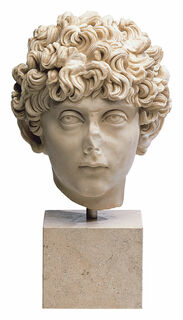Quick info
museum replica | artificial marble | handmade | height 44 cm
Detailed description
Emperor Marcus Aurelius
A court sculptor of Hadrianic tradition carved this strikingly handsome portrait of a young man from marble. The very special personality of the young man Marcus Aurelius is portrayed by his luxurious curls and his soft, upturned lips.
Original: The Norbert Schimmel Collection, New York. Hadrianic, marble. Approx. 140 - 170 AD.
Polymer ars mundi museum replica cast by hand, height with pedestal 44 cm.
Sculptural representation of person's head and shoulders.
Marble powder is polymer-bonded. Artificial marble is characterised by a fine white surface that appears very similar to marble.
A true-to-the-original reproduction of an artwork in the same size and with the best possible material and colour uniformity.
The mould is usually taken directly from the original so that the replication reproduces even the finest details. After casting the replication, using the most appropriate method, the surface is polished, patinated, gilded or painted according to the original.
A replication of ars mundi is a recognizable copy of the original.
Roman art is primarily determined by the fusion of native Italic and Greek Hellenistic elements.
The pragmatic and political aspects serving the expansion of the empire played a decisive part in architecture.
In the sacral sphere, the early temples of Rome copied the Etrurian-Italic type. The Roman secular buildings, such as bridges, ports, aqueducts, walls, gates, etc. played a far more important role.
With the remodelling of the Forum Romanum by Augustus and the redesign of the Forum of Augustus, the importance of the old city centres changed. They became large enclosed outdoor space complexes. Axial symmetry aligned with a podium temple is characteristic of the period. The temples and theatres that were built in the "eternal city" under the reign of Emperor Augustus with their round dynamic designs diverged steadily from the straight-lined Greek models.
The round sculptural works of the Roman period were initially dominated by copies and redesigns of Greek models. Independent achievements of Roman sculptors arose in the field of portraits, whereby in Rome, the form of the bust was preferred. A preference for ornamentation without neglecting the substantive content is visual in Roman relief art.
Triumphal paintings that were carried in processions to honour glorious commanders were typical for the painting. The re-excavated Vesuvian cities of Pompeii, Herculaneum, Stabiae and Oplontis provide the richest overview of mural painting.
A similarity to painting is found in mosaic art which was mainly used for the decorative design of floors and walls.
Some areas of minor arts flourished exceedingly in Roman times. Toreutics, the art of working metal, produced precious silver vessels. The art of glassblowing is documented by numerous excellent finds. Glyptic (the art of carving on precious stones) produced magnificent reliefs carved from semi-precious stones, engraved gems and cameos depicting official themes.
The extensive coinage in Roman times contributed to spreading the portraits of the rulers over the entire territory of the Roman Empire.
A plastic work of sculptural art made of wood, stone, ivory, bronze or other metals.
While sculptures from wood, ivory or stone are made directly from the block of material, in bronze casting a working model is prepared at first. Usually, it is made of clay or other easily mouldable materials.
The prime time of sculpture after the Greek and Roman antiquity was the Renaissance. Impressionism gave a new impulse to the sculptural arts. Contemporary artists such as Jorg Immendorf, Andora, and Markus Lupertz also enriched sculptures with outstanding works.


